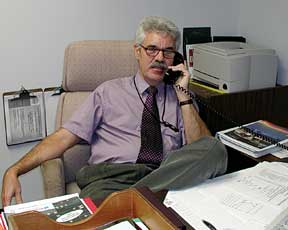 John
Dawson is the head of the Electromagnetic Environmental Effects
Division (5.1.7) of the Naval Air Systems Command (NAVAIR), Naval
Air Warfare Center Aircraft Division (NAWCAD) at Patuxent River,
Maryland.
John
Dawson is the head of the Electromagnetic Environmental Effects
Division (5.1.7) of the Naval Air Systems Command (NAVAIR), Naval
Air Warfare Center Aircraft Division (NAWCAD) at Patuxent River,
Maryland.
He received a BSEE from the University of Maryland and a MSSM
from the University of Southern California.
John has worked for the last 32 years in the research, development,
test and evaluation (RDT&E) of Electromagnetic Environmental
Effects (E3) within the Department of Defense (DoD). All of this
time was spent in just one place, the "Shielded Hangar"
at Patuxent River, Maryland.
John started as a GS-02 Student Trainee in a Co-Op program designed
to develop Electrical Engineers for the Navy. Ron Lane, who many
of the old timers in EMC will remember, was John's first supervisor
and mentor. John worked every job there is from sweeping floors,
wiring aircraft, recording and reporting data, to testing every
Navy aircraft type in the Fleet since 1970. His first test was
on a P-3A and the last was on an F-18C. He has been a student,
technician, E3 engineer, Section Head, Branch Head, Chief Engineer
and now Division Head. John has way too many sea stories for this
short article, but those of you who know him will attest that
they tend to get better with age.
Most of John's efforts and struggles over the years have been
in the continual development of the E3 T&E capabilities and
facilities at Patuxent River, now estimated at a $428M replacement
cost. John says, "It feels like I have been fighting to develop
these capabilities my entire career. My senior thesis in college
was on the design of an anechoic test chamber for E3, in what
was then the "Nose Bay" of the Shielded Hangar. This
facility became a reality in 1983. I also spent over 25 years
designing and selling the development and construction of an even
larger anechoic chamber, the Advanced Systems Integration Laboratory
(ASIL), which was finally erected in 1999. Anyone who has ever
been involved with Military Construction (MILCON) projects will
tell you that they may average 15 years from concept to construction,
with many of the projects cancelled along the way. I have survived
three so far, with one still in the "hopper". I hope
to see a large aircraft sized TEM/Reverberation chamber (Joint
Army/Navy MILCON) become reality, before I retire."
John was involved in the first EMP testing at Patuxent River in
1972 and worked to build an EMP capability which has grown over
the years, to where PAX River is one of only a handful of full-scale,
full threat open-air facilities still operational in the world
today.
Electromagnetic Vulnerability testing has been ongoing at Patuxent
River since 1964 and PAX River has evolved into one of the largest
most technically capable facilities within DoD. This last year,
PAX River conducted the first successful FAA/JAA High Intensity
Radiated Fields (HIRF) testing of a LearJet M-45. PAX River is
poised and ready to test and evaluate the next generation aircraft,
i.e. Joint Strike Fighter (JSF).
John also spent 9 years dabbling with lightning testing, using
equipment that dated back to the 1939 World's Fair. PAX River's
current lightning/ESD capabilities are now fully mobile and include
capabilities for Near Strike testing, ESD and Lightning EMP.
John is a strong proponent of E3 Certification and Accreditation.
All of the personnel, government and contractor, are or will be,
NARTE certified. All of the TEMPEST personnel have received specialized
training, and there are two Certified TEMPEST Technical Authorities
within his Division. The EMI Laboratories are National Voluntary
Laboratory Accreditation Program (NVLAP) accredited test facilities
and the T&E processes and practices have all been standardized.
John believes that we cannot expect others to be accountable,
if we do not practice accountability and standardization ourselves.
He is also a strong proponent of consolidating all of the E3 organizations
within NAVAIR. He spent the last 25 years extolling the efficiencies
and effectiveness that could be achieved, if everyone worked in
one Division. He has seen E3 capabilities diminish within the
services over the years and he believes that we may soon see a
day where there will be only one or two E3 RDT&E facilities
within DoD. John has made it his personal mission to ensure Patuxent
River is viewed as the DoD Laboratory of choice for E3 RDT&E
so they will be one of the E3 facilities left standing.
John says, "I have been blessed and fortunate to work with
some of the finest E3 professionals within the DoD. I believe
the secret to successful management is finding ways to give your
folks the tools and training they need to do their job, then step
aside and let them do it, while finding ways to protect them from
all the distractions that may develop. Everyone wants to do a
good job, and given the opportunity, their combined talents, creativity
and drive to support the men and women in the Fleet, our folks
are the very best. I am very proud of them and their accomplishments
and look forward to a continued bright and successful future."
John is a NARTE Certified Electromagnetic Compatibility Engineer
- EMC-000683-NE. He is a member of the Acquisition Professional
Community and the Association for Unmanned Vehicle Systems International
(AUVSI).
John has been married to Maria "Cristina" Dawson for
27 years. They have two children, Michael (24) and Teresa (22).
John and Cristina live near the Potomac River and he enjoys gardening,
observing wildlife and fishing. EMC